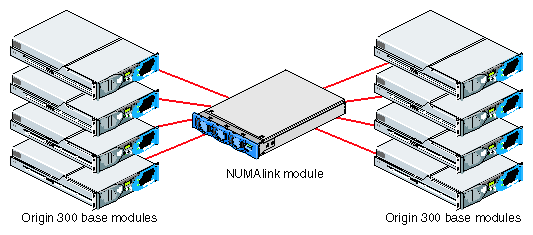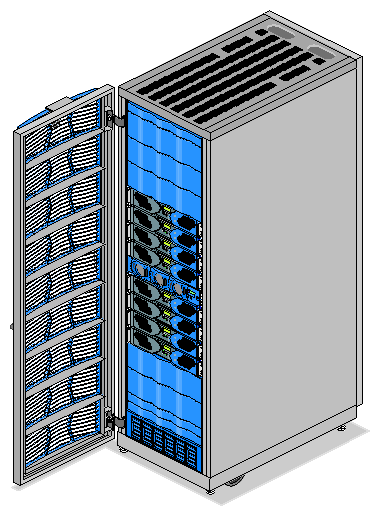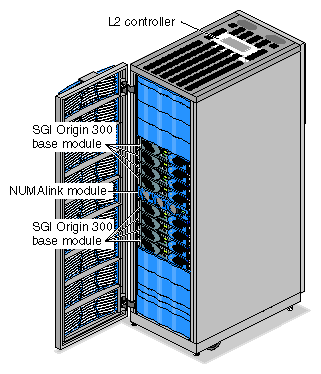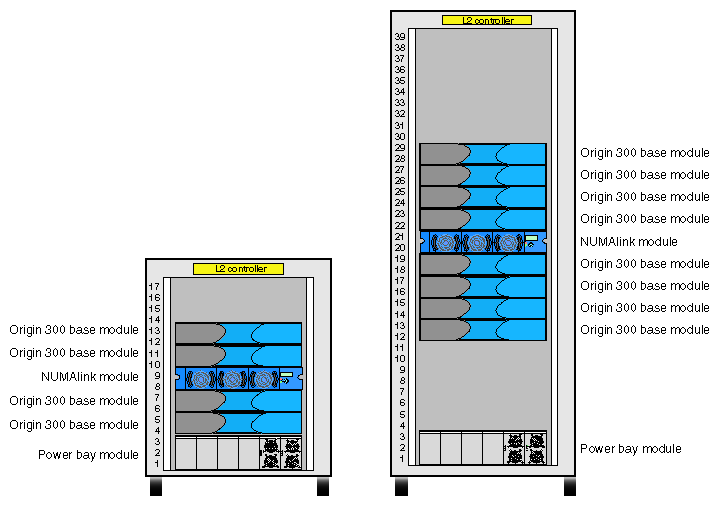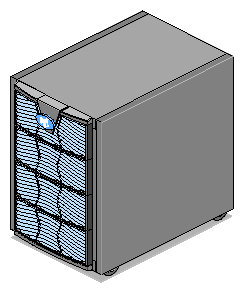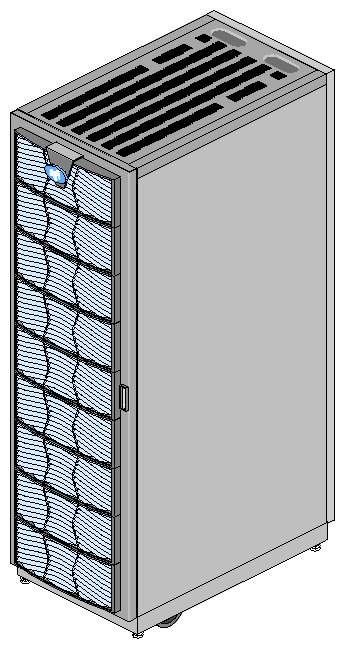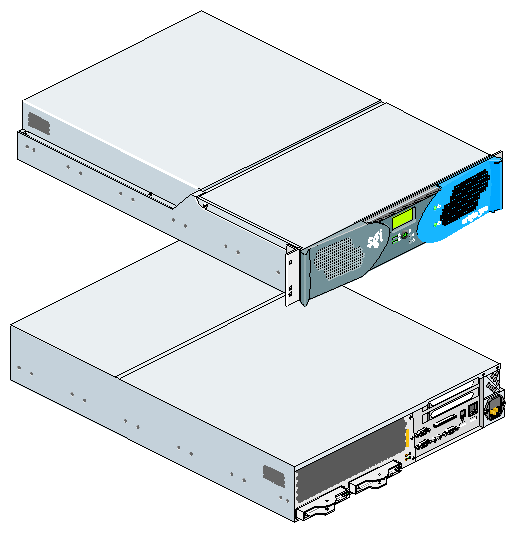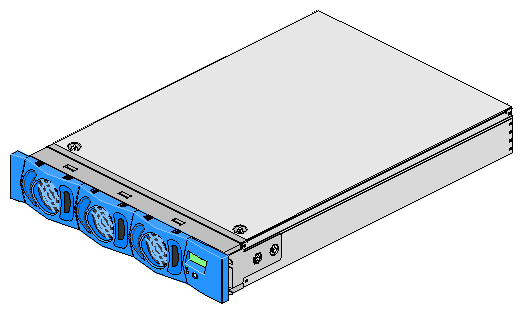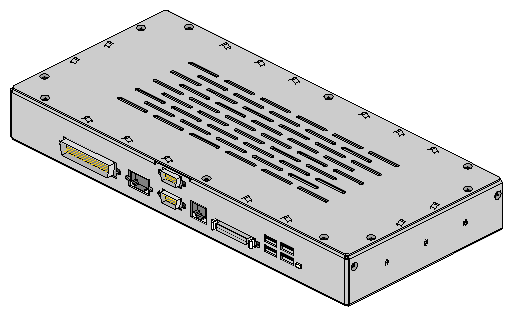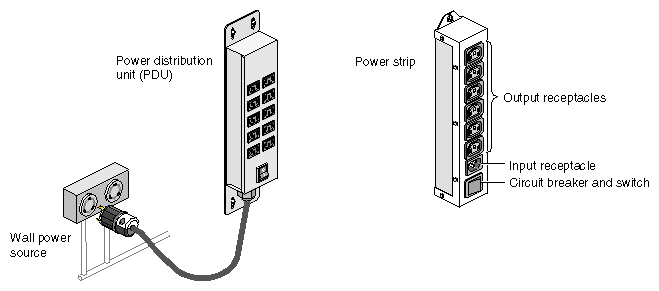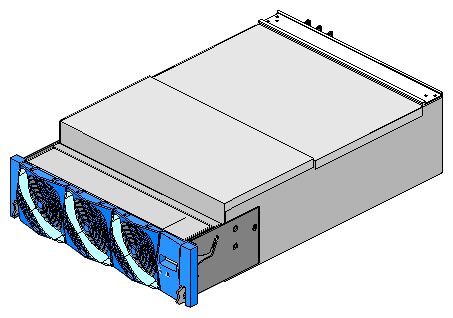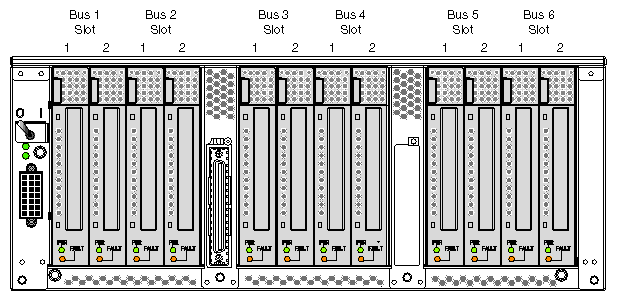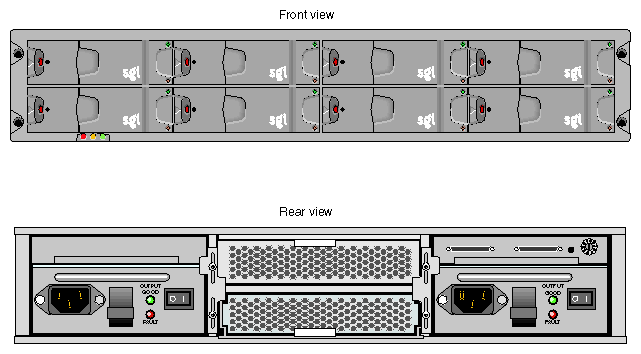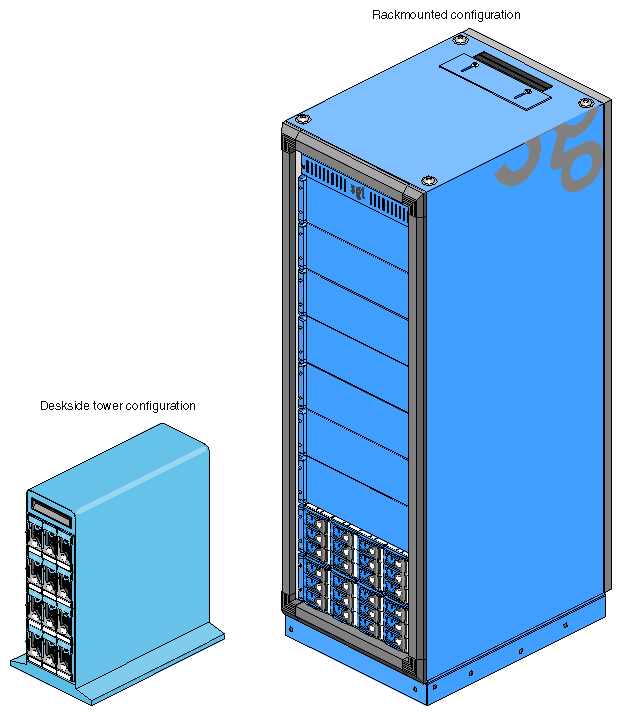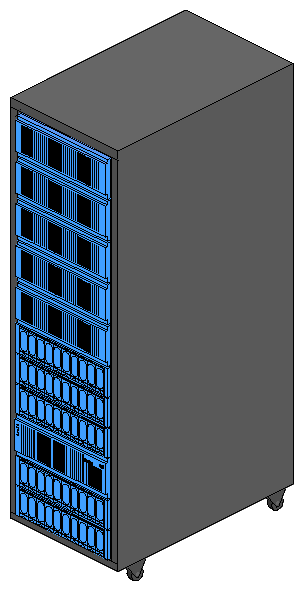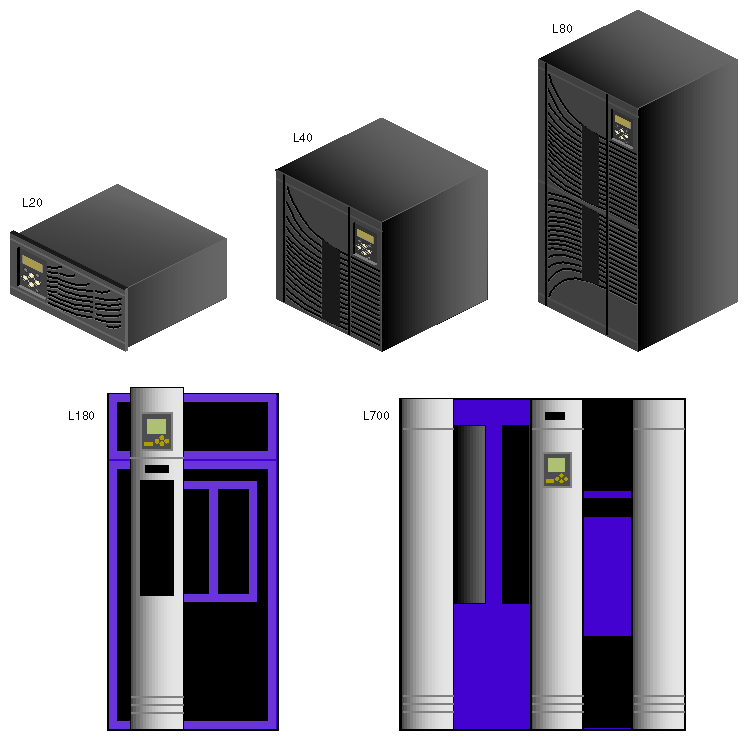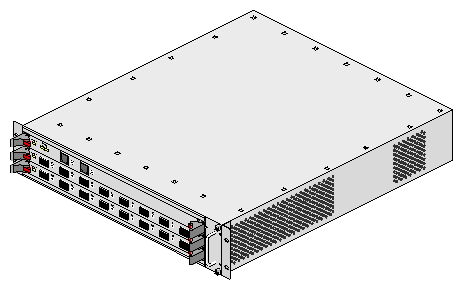The SGI Origin 300 system with NUMAlink module is a distributed shared memory (DSM) and distributed I/O system. As a DSM system, each Origin 300 base module (2 or 4 processors) has local memory that it shares with the other base modules in the system. Similar to DSM, the interfaces of the I/O devices are distributed among the Origin 300 base modules and are accessible by all base modules.
The key component that makes the distributed shared memory and I/O possible is the NUMAlink 3 interconnect. In this system, the NUMAlink 3 interconnect consists of a NUMAlink module that transfers messages between the Origin 300 base modules (refer to Figure 1-1). In an Origin 300 system that does not have a NUMAlink module, the NUMAlink 3 interconnect consists of a cable that connects two Origin 300 base modules.
| Note: The maximum number of base modules in an Origin 300 system that does not contain a NUMAlink module is two (8 processors). In an Origin 300 system that does contain a NUMAlink module, the maximum number of base modules is eight (32 processors). |
To increase the number of processors beyond 32, Origin 300 with NUMAlink module systems can be clustered together. The maximum number of processors in a clustered configuration is 128.
The Origin 300 system with NUMAlink module is based on SGI NUMA (formerly ccNUMA), a cache-coherent non-uniform memory access architecture, which ensures that the caches of the processors contain valid data. For example, if a processor alters the data in a cache location and another processor has a copy of that data in its cache, the processor that holds the copy will be notified that the memory location no longer contains valid data. SGI NUMA architecture also supports varied access times for local and remote memory references.
The SGI Origin 300 system with NUMAlink module is a scalable system, which means that you can scale the system in independent dimensions: computing, I/O, and storage (refer to Table 1-1). For example, the computing dimension can range from 4 to 32 processors in a single system image (SSI).
Table 1-1. Minimum and Maximum System Configurations
Dimension | Minimum | Maximum |
|---|---|---|
Computing: |
|
|
Base modules | 2 | 8 |
Processors | 4 (two 2-processor Origin 300 base modules) | 32 (eight 4-processor Origin 300 base modules) |
Memory | 1 GB (two Origin 300 base modules) | 32 GB (eight Origin 300 base modules) |
I/O | 4 PCI slots (two Origin 300 base modules) | 56 PCI slots (four Origin 300 base modules and four PCI expansion modules) |
Storage | 2 disk drives (one drive per Origin 300 base module; the second disk drive of a base module is optional) | 16 disk drives (eight Origin 300 base modules); however, additional storage can be added to the system. The maximum amount of storage depends on the type of storage expansion device. |
The Origin 300 system has many of the same features that are available in the Origin 3000 product line to increase the reliability, availability, and serviceability (RAS ) of the system.
Internal power and temperature are monitored via the L1 controller; the L1 controller automatically shuts down the base module to prevent overheating when necessary.
Memory and secondary cache are protected by single-bit error correction and double-bit error detection (SECDED).
Primary cache is protected by parity.
Memory can be scrubbed when a single-bit error occurs.
The IRIX operating system can be recovered on some kernel double-bit errors.
Automatic testing occurs after you power on the system and disables processors and memory that fail these self-tests.
Boot times are minimized.
Remote console and maintenance activities are supported.
System control network for system maintenance and monitoring is supported.
LED values are readable via the system controller network.
Figure 1-2 shows the Origin 300 system with NUMAlink module.
The SGI Origin 300 system with NUMAlink module consists of the following base components, as shown in Figure 1-3. This section provides a brief overview of the base components; detailed information is provided in Appendix A.
One rack
Two to eight SGI Origin 300 base modules (also referred to as servers)
One NUMAlink module
One USB hub
One L2 controller
One or more power components (for example, power distribution unit (PDU), power strip, and power bay module)

Note: The modules of the SGI Origin 300 system with NUMAlink module are not interchangeable with the SGI Origin 3000 series bricks.
The SGI Origin 300 system with NUMAlink module supports two rack types: a short rack and a tall rack. The racks are measured in standard units (U); one unit is equal to 1.75 in. (4.45 cm). The short rack is a 17U rack and the tall rack is a 39U rack (refer to Figure 1-4).
The components within the rack are identified by the lowest unit number that they occupy. For example, the NUMAlink modules shown in Figure 1-4 are identified as U8 in the short rack and U20 in the tall rack.
Both rack types have the following characteristics:
19-in. mounting rails to support the components within the rack.
Front and rear doors.
Cable management hardware in the rear of the rack.
Four castors, two of which are swivel castors.
Seismic tie-down attachment points.

Note: Tall racks also have leveling pads; short racks do not have leveling pads.
Figure 1-5 shows the front view of the short rack.
Figure 1-6 shows the front view of the tall rack.
The SGI Origin 300 system with NUMAlink module consists of two to eight Origin 300 base modules that provide the compute functionality for the system. These base modules, or servers, communicate with each other via the NUMAlink 3 interconnect.
Each base module consists of:
Two or four 64-bit MIPS RISC processors
2 MB of secondary cache per processor
512 MB to 4 GB of memory
One or two sled-mounted Ultra3 SCSI disk drives
Zero to two PCI cards

Note: A base module is not limited to two disk drives or two PCI slots. The base module can connect to external devices that expand the I/O and storage capabilities. Information about these devices is provided in “Optional System Components”.
Each base module also contains an L1 controller that provides the following services:
Controls and sequences power
Controls and monitors the environment
Initiates a reset
Stores identification and configuration information
Figure 1-7 shows the front and rear views of an SGI Origin 300 base module.
The NUMAlink module, shown in Figure 1-8, is an air-cooled device that transfers messages between the Origin 300 base modules via the NUMAlink 3 interconnect. The NUMAlink module consists of eight ports; four ports can connect to four Origin 300 base modules. The other four ports, which carry USB signals, can connect to Origin 300 base modules or PCI expansion modules.
| Note: The USB signals enable the Origin 300 base modules and the PCI expansion modules to communicate with the L2 controller. The Origin 300 base modules that connect to the four ports that do not carry USB signals communicate with the L2 controller via a USB hub. |
There are two types of NUMAlink modules: an AC-powered NUMAlink module and a DC-powered NUMAlink module. The functionality of these two modules is the same; however, as the names imply, the modules receive power from different sources. The AC-powered router receives AC voltage from a PDU or power strip. The DC-powered NUMAlink module receives DC voltage from a power bay.
The USB hub, shown in Figure 1-9, routes information between the L2 controller and the four Origin 300 base modules that connect to NUMAlink module ports 1, 6, 7, and 8 (the ports that do not carry USB signals).
The L2 controller, shown in Figure 1-10, is a rack-level controller that performs the following functions:
Controls resource sharing.
Controls L1 controllers.
Maintains controller configuration and topology information.
Enables remote maintenance.
Routes data between upstream and downstream devices, as follows:
Upstream devices (for example, the system console) provide control for the system, initiate commands for the downstream devices, and act on the messages that they receive from downstream devices.
Downstream devices (for example, L1 controllers) perform the actions specified by the L2 controller commands, send responses to the L2 controller that indicate the status of the commands, and send error messages to the L2 controller.
The SGI Origin 300 system with NUMAlink module can consist of the following power components:
One or two power distribution units (PDUs) (refer to Figure 1-11) - The second PDU is added to the system when more than 15 AC power receptacles are needed within the rack.
The PDU inputs AC voltage from an external power receptacle and it can output AC voltage to the Origin 300 base modules, an AC-powered NUMAlink module, optional SGI Total Performance 900 (TP900) storage modules, USB hub, power bay module, power strip, and Myrinet-2000 switch.
One power strip - The power strip exists in the system when the system requires 11 to 15 AC power receptacles.
The power strip inputs AC voltage from the PDU and it can output AC voltage to the Origin 300 base modules, an AC-powered NUMAlink module, optional TP900 storage modules, USB hub, power bay module, and Myrinet-2000 switch.
One power bay module (refer to Figure 1-12) - The power bay module exists in the system when the system contains a DC-powered NUMAlink module or a PCI expansion module.
The power bay module inputs AC voltage from a PDU or power strip and converts this AC voltage to 12 Vdc standby voltage and 48 Vdc. The power bay outputs this voltage to the DC-powered NUMAlink module, the L2 controller, and PCI expansion modules. The 48 Vdc powers on the NUMAlink module, the PCI expansion modules, and the L2 controller. The 12 Vdc standby voltage powers on the L1 controller logic within the NUMAlink module and the PCI expansion modules.
The power bay module can house up to six power supplies; however, this system requires only two or three power supplies. The third power supply is required when the system has four PCI expansion modules. The outputs of the power supplies are bused together. For example, when the power bay contains two power supplies, the supplies provide the following power in an N+1 redundant configuration: 1840 W at 48 Vdc and 90 W at 12 Vdc standby.
One power supply - When the system has an AC-powered NUMAlink module, the L2 controller receives power from a power supply that is attached to the side of the rack. This power supply receives AC voltage from a PDU or power strip and converts the voltage to 48 Vdc, which is the input voltage that the L2 controller requires.
The Origin 300 system can contain the following optional components, which are discussed in the subsections that follow.
PCI expansion modules
Storage expansion modules
Tape devices
CD-ROM
Myrinet-2000 switch
Each Origin 300 base module contains two PCI slots; however, you can expand your I/O capabilities by adding one to four PCI expansion modules to your system. The following rules indicate how many PCI expansion modules you can add to your system:
You can add one PCI expansion module to a system that contains two to seven base modules.
You can add two PCI expansion modules to a system that contains two to six base modules.
You can add three PCI expansion modules to a system that contains three to five base modules.
You can add four PCI expansion modules to a system that contains four base modules.
The PCI expansion module, shown in Figure 1-13, contains six buses (buses 1 through 6) that can seat as many as twelve 3.3-V or universal PCI cards. Each bus has two PCI slots (refer to Figure 1-14) that are labeled 1 and 2 and support either two 33-MHz PCI cards or two 66-MHz PCI cards.
The PCI expansion module connects to an Origin 300 base module via the NUMAlink module.
Figure 1-14 shows the PCI card slot numbering on the PCI expansion module.
Each Origin 300 base module contains two disk-drive bays; however, you can add additional storage to the system as follows:
For a SCSI (small computer system interface) JBOD (just a bunch of disks) solution, SGI offers the SGI Total Performance 900 (TP900) storage module.
For a Fibre Channel solution that supports both JBOD and RAID configurations, SGI offers the SGI Total Performance 9100 (TP9100) storage system.
For a Fibre Channel RAID solution, SGI offers the SGI Total Performance 9400 (TP9400) storage system.
These solutions are discussed in the subsections that follow.
The SGI TP900 storage module, shown in Figure 1-15, is a 2U-high 8-drive storage system that provides compact, high-capacity, high-availability JBOD storage for the Origin 300 base modules. The enclosure backplane connects the 8 drives on one SCSI bus. As an option, the storage module can also be configured on two SCSI buses (two strings of 4 drives).
This storage module has the following features:
Affordable.
Mounts in a standard 19-in. rack; available in factory-installed configurations with the Origin 300 base modules.
Uses SCSI Parallel Interface 3 (SPI-3) capable Low Profile (1-inch high) 3.5-inch disk drives.
Has drive carriers that accept SGI-qualified 10,000- or 15,000-RPM U160 SCSI disk drives.
Is AC-powered. Receives 200/240 Vac input power from the PDU or power strip.
The SGI Total Performance 9100 (TP9100), shown in Figure 1-16, is an affordable, entry-level RAID storage array that is easily expandable and comes in either a deskside tower or a rackmounted configuration. You can start with a basic JBOD configuration and later add RAID controllers or you can start with a RAID configuration. By purchasing a deskside model, you can start small and scale to a multi-terabyte environment. The drives within the deskside tower can easily slide into a rack to increase storage capacity. The compact design of the TP9100 enables as many as 108 drives to fit in a single cabinet.
This storage system has the following features:
Converts easily from JBOD to RAID.
Supports RAID levels 0, 1, 1+0, 3, and 5.
Has one RAID controller and can be upgraded to two controllers, allowing no single point of failure.
Supports the latest in high-performance 18-GB, 36-GB, or 73-GB 10,000-RPM FC-AL (Fibre Channel-arbitrated loop) drives.
Can be configured with as many as 60 drives per controller.
Supports multi-platform OS-based servers: IRIX, Linux, Microsoft Windows NT, and Microsoft Windows 2000.
Has been fully tested in SAN and switch environments.
Supports nine TP9100 arrays in a single cabinet, for a maximum of 108 drives per cabinet.
Supports uninterrupted data access with automatic failover capability and hot-swappable, redundant components.
The SGI Total Performance 9400 (TP9400), shown in Figure 1-17, is a highly scalable RAID storage subsystem. It supports more than 8 TB of fast storage in a 19-inch rack enclosure and can grow from as few as 72 GB of storage to whatever size you require without disruption to normal processing activities. The TP9400 has continuous availability; all active components may be configured redundantly and installed “hot” as customer replaceable or expansion units.
This storage system has the following features:
Supports full RAID storage, which is implemented in hardware with custom ASICs for performance.
Has a total Fibre Channel design, including all-fiber dual-ported disk drives.
Supports as many as eight internal optical fiber hubs for online expansion and connectivity.
Has four Fibre Channel loops that support I/O reads as fast as 357 MB/s and writes as fast as 239 MB/s.
Supports direct attachment of up to eight host systems using optical fiber cables.
Supports all SAN topologies.
Supports dual active controllers with as much as 1 GB of redundant cache and dual battery backup.
Has user-friendly GUI or command line interface software for installation and management.
Has in-band and out-of-band management, including e-mail event notification.
Supports as many as 110 drives in each rack (36- or 73-GB 10,000-RPM drives).
Supports system and file clustering.
Has host failover software that supports logical volume management and load balancing.
The Origin 300 base module supports the following DAT (digital audio tape) option:
All of the following tape devices have faster transfer rates, can store larger amounts of data, and in general terms, are more reliable and more scalable than the DAT option. The main differences between these devices is the mode of operation; they are either start/stop devices or streaming devices. Start/stop devices are better suited for HSM (hierarchical storage management) applications where access to the first byte of data is critical and heavy start and stop activity takes place. Streaming devices are better suited for backup and restore applications where massive amounts of data are being written and read in one operation.
The start/stop devices are:
9840. Offers SCSI and native Fibre Channel connectivity, storage capacity of 20 GB (native), and a data transfer rate of 10 MB/s.
9840B. Offers SCSI and native Fibre Channel connectivity, storage capacity of 20 GB (native), and a data transfer rate of 20 MB/s.
9940. Offers SCSI and native Fibre Channel connectivity, storage capacity of 60 GB (native), and a data transfer rate of 10 MB/s.
The streaming devices are:
DLT (digital linear tape) 8000 (7000 emulation). Offers SCSI connectivity, storage capacity of 35 GB, and a data transfer rate of 5.0 MB/s.
DLT 8000 (native mode). Offers SCSI connectivity, storage capacity of 40 GB, and a data transfer rate of 6.0 MB/s.
ULTRIUM LTO. Offers SCSI connectivity, storage capacity of 100 GB (native), and a data transfer rate of 15 MB/s.
SDLT. Offers SCSI connectivity, storage capacity of 110 GB, and a data transfer rate of 11 MB/s. The SDLT is backward read compatible (BRC) with DLT 4000, DLT 7000, and DLT 8000 drives; however, SDLT performance is affected when reading legacy media.
The 4mm DAT can be mounted in the Origin 300 rack or placed on a table. All other supported tape devices are housed within one of the following libraries: L20, L40, L80, L180, or L700 (refer to Table 1-2 and Figure 1-18).
| Note: In Table 1-2, device transfer rates are dictated by the profile of the data being transferred and are likely to be less than the rated speed, depending on the size of files and the block size. |
Table 1-2. Tape Drive Libraries
Library | Specifications |
|---|---|
Number of cartridge slots: 10 or 20 Number of drives: 1 or 2 Supported drives: DLT 8000 (native mode), ULTRIUM LTO, and SDLT Cartridge capacity: DLT 8000: 800 GB (20 slots, UNC) - 1.6 TB (20 slots, COM) ULTRIUM LTO: 2.0 TB (20 slots, UNC) - 4.0 TB (20 slots, COM) SDLT: 2.2 TB (20 slots, UNC) - 4.4 TB (20 slots, COM) Drive data rate: DLT 8000: 43.2 GB/hr (2 drives, UNC) - 86.4 GB/hr (2 drives, COM) ULTRIUM LTO: 108 GB/hr (2 drives, UNC) - 216 GB/hr (2 drives, COM) SDLT: 79.2 GB/hr (2 drives, UNC) - 158.4 GB/hr (2 drives, COM) | |
Number of cartridge slots: 20 or 40 Number of drives: 1 to 4 Supported drives: DLT 8000 (native mode), ULTRIUM LTO, and SDLT Cartridge capacity: DLT 8000: 1.6 TB (40 slots, UNC) - 3.2 TB (40 slots, COM) ULTRIUM LTO: 4.0 TB (40 slots, UNC) - 8.0 TB (40 slots, COM) SDLT: 4.4 TB (40 slots, UNC) - 8.8 TB (40 slots, COM) Drive data rate: DLT 8000: 86.4 GB/hr (4 drives, UNC) - 172.8 GB/hr (4 drives, COM) ULTRIUM LTO: 216 GB/hr (4 drives, UNC) - 432 GB/hr (4 drives, COM) SDLT: 158.4 GB/hr (4 drives, UNC) - 316.8 GB/hr (4 drives, COM)
Key: UNC = uncompressed, COM = compressed | |
Number of cartridge slots: 40, 60, or 80 Number of drives: 1 to 8 Supported drives: DLT 8000 (native mode), ULTRIUM LTO, and SDLT Cartridge capacity: DLT 8000: 3.2 TB (80 slots, UNC) - 6.4 TB (80 slots, COM) ULTRIUM LTO: 8.0 TB (80 slots, UNC) - 16.0 TB (80 slots, COM) SDLT: 8.8 TB (80 slots, UNC) - 17.6 TB (80 slots, COM) Drive data rate: DLT 8000: 172.8 GB/hr (8 drives, UNC) - 345.6 GB/hr (8 drives, COM) ULTRIUM LTO: 432 GB/hr (8 drives, UNC) - 864 GB/hr (8 drives, COM) SDLT: 316.8 GB/hr (8 drives, UNC) - 633.6 GB/hr (8 drives, COM)
| |
Number of cartridge slots: 84, 140, or 174 Number of drives: 1 to 10 Supported drives: DLT 8000 (native mode), DLT 8000 (7000 emulation), ULTRIUM LTO, and SDLT or Number of drives: 1 to 6 Supported drives: 9840 and 9840B Cartridge capacity: DLT 8000 (native): 6.96 TB (174 slots, UNC) - 13.92 TB (174 slots, COM) DLT 8000 (7000 em): 6.09 TB (174 slots, UNC) - 12.18 TB (174 slots, COM) ULTRIUM LTO: 17.4 TB (174 slots, UNC) - 34.8 TB (174 slots, COM) SDLT:- 19.14 TB (174 slots, UNC) - 38.28 TB (174 slots, COM) 9840: 3.48 TB (174 slots, UNC) - 6.96 TB (174 slots, COM) Drive data rate: DLT 8000 (native): 216 GB/hr (10 drives, UNC) - 432 GB/hr (10 drives, COM) DLT 8000 (7000 em): 180 GB/hr (10 drives, UNC) - 360 GB/hr (10 drives, COM) ULTRIUM LTO: 540 GB/hr (10 drives, UNC) - 1.08 TB/hr (10 drives, COM) SDLT: 396 GB/hr (10 drives, UNC) - 792 GB/hr (10 drives, COM) 9840: 216 GB/hr (6 drives, UNC) - 432 GB/hr (6 drives, COM) 9840b: 432 GB/hr (6 drives, UNC) - 864 GB/hr (6 drives, COM) |
Table 1-3 lists the supported tape options and their specifications.
Table 1-3. Tape Drive Comparison Chart
Tape Device | Interface | Media Capacity | Transfer Rate | Mount Location |
|---|---|---|---|---|
4mm DAT | SCSI | 20 GB | 2.36 MB/s | Origin 300 rack or table |
9840 | SCSI and | 20 GB | 10 MB/s | L180 or L700 |
9840B | SCSI and | 20 GB | 20 MB/s | L180 or L700 |
DLT 8000 | SCSI | 35 GB | 5 MB/s | L180 or L700 |
DLT 8000 (native mode) | SCSI | 40 GB | 6 MB/s | All libraries |
9940 | SCSI and | 60 GB | 10 MB/s | L700 |
ULTRIUM LTO | SCSI | 100 GB | 15 MB/s | All libraries |
SDLT | SCSI | 110 GB | 11 MB/s | All libraries |
The 40X CD-ROM drive is a half-height, high capacity (approximately 600 MB, formatted), high-performance device that is packaged in a custom external enclosure designed to match other SGI external peripherals. It is capable of transferring data at up to 6.0 MB/s. It can connect to the Origin 300 base module via the SCSI port connector or a SCSI PCI card.
The Myrinet-2000 switch is a 16-port switch that provides the network fabric necessary to cluster up to four 32-processor Origin 300 with NUMAlink module systems. It is a high-performance packet communication and switching technology that interconnects the clusters of base modules via full-duplex 2+2 Gb/s links.
The Origin 300 base modules connect to the switch via a fiber cable and a Myrinet PCI card.
